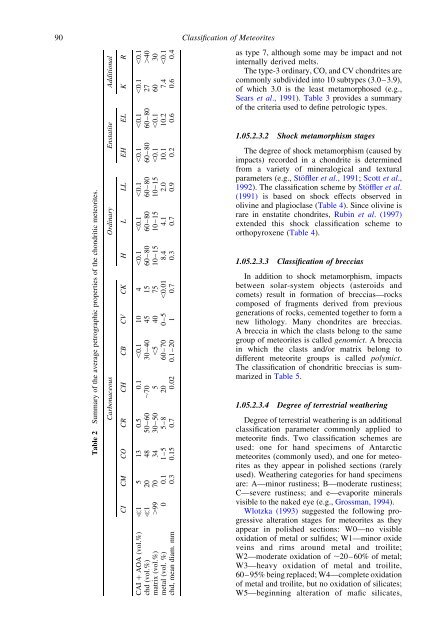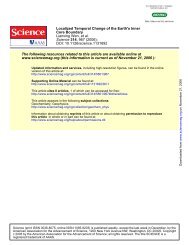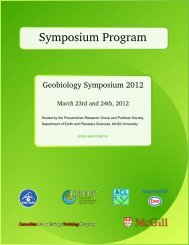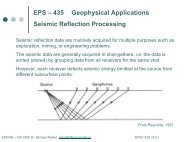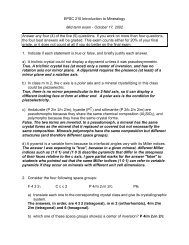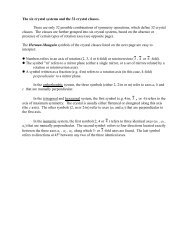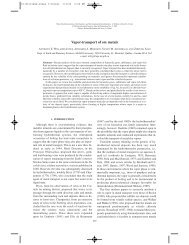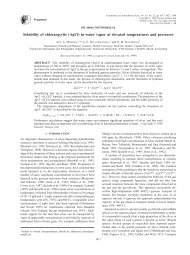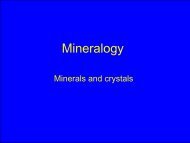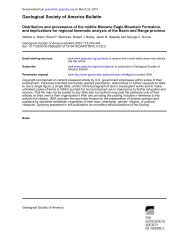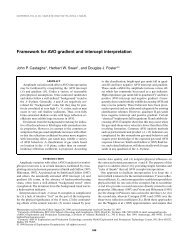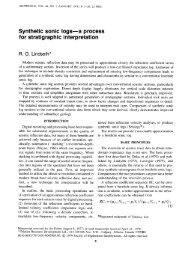05 Classification of.. - Department of Earth and Planetary Sciences
05 Classification of.. - Department of Earth and Planetary Sciences
05 Classification of.. - Department of Earth and Planetary Sciences
Create successful ePaper yourself
Turn your PDF publications into a flip-book with our unique Google optimized e-Paper software.
90<br />
<strong>Classification</strong> <strong>of</strong> Meteorites<br />
Table 2 Summary <strong>of</strong> the average petrographic properties <strong>of</strong> the chondritic meteorites.<br />
Carbonaceous Ordinary Enstatite Additional<br />
CI CM CO CR CH CB CV CK H L LL EH EL K R<br />
CAI þ AOA (vol.%) p1 5 13 0.5 0.1 ,0.1 10 4 ,0.1 ,0.1 ,0.1 ,0.1 ,0.1 ,0.1 ,0.1<br />
chd (vol.%) p1 20 48 50–60 ,70 30–40 45 15 60–80 60–80 60–80 60–80 60–80 27 .40<br />
matrix (vol.%) .99 70 34 30–50 5 ,5 40 75 10–15 10–15 10–15 ,0.1 ,0.1 60 30<br />
metal (vol. %) 0 0.1 1–5 5–8 20 60–70 0–5 ,0.01 8.4 4.1 2.0 10.1 10.2 7.4 ,0.1<br />
chd, mean diam. mm 0.3 0.15 0.7 0.02 0.1–20 1 0.7 0.3 0.7 0.9 0.2 0.6 0.6 0.4<br />
as type 7, although some may be impact <strong>and</strong> not<br />
internally derived melts.<br />
The type-3 ordinary, CO, <strong>and</strong> CV chondrites are<br />
commonly subdivided into 10 subtypes (3.0–3.9),<br />
<strong>of</strong> which 3.0 is the least metamorphosed (e.g.,<br />
Sears et al., 1991). Table 3 provides a summary<br />
<strong>of</strong> the criteria used to define petrologic types.<br />
1.<strong>05</strong>.2.3.2 Shock metamorphism stages<br />
The degree <strong>of</strong> shock metamorphism (caused by<br />
impacts) recorded in a chondrite is determined<br />
from a variety <strong>of</strong> mineralogical <strong>and</strong> textural<br />
parameters (e.g., Stöffler et al., 1991; Scott et al.,<br />
1992). The classification scheme by Stöffler et al.<br />
(1991) is based on shock effects observed in<br />
olivine <strong>and</strong> plagioclase (Table 4). Since olivine is<br />
rare in enstatite chondrites, Rubin et al. (1997)<br />
extended this shock classification scheme to<br />
orthopyroxene (Table 4).<br />
1.<strong>05</strong>.2.3.3 <strong>Classification</strong> <strong>of</strong> breccias<br />
In addition to shock metamorphism, impacts<br />
between solar-system objects (asteroids <strong>and</strong><br />
comets) result in formation <strong>of</strong> breccias—rocks<br />
composed <strong>of</strong> fragments derived from previous<br />
generations <strong>of</strong> rocks, cemented together to form a<br />
new lithology. Many chondrites are breccias.<br />
A breccia in which the clasts belong to the same<br />
group <strong>of</strong> meteorites is called genomict. A breccia<br />
in which the clasts <strong>and</strong>/or matrix belong to<br />
different meteorite groups is called polymict.<br />
The classification <strong>of</strong> chondritic breccias is summarized<br />
in Table 5.<br />
1.<strong>05</strong>.2.3.4 Degree <strong>of</strong> terrestrial weathering<br />
Degree <strong>of</strong> terrestrial weathering is an additional<br />
classification parameter commonly applied to<br />
meteorite finds. Two classification schemes are<br />
used: one for h<strong>and</strong> specimens <strong>of</strong> Antarctic<br />
meteorites (commonly used), <strong>and</strong> one for meteorites<br />
as they appear in polished sections (rarely<br />
used). Weathering categories for h<strong>and</strong> specimens<br />
are: A—minor rustiness; B—moderate rustiness;<br />
C—severe rustiness; <strong>and</strong> e—evaporite minerals<br />
visible to the naked eye (e.g., Grossman, 1994).<br />
Wlotzka (1993) suggested the following progressive<br />
alteration stages for meteorites as they<br />
appear in polished sections: W0—no visible<br />
oxidation <strong>of</strong> metal or sulfides; W1—minor oxide<br />
veins <strong>and</strong> rims around metal <strong>and</strong> troilite;<br />
W2—moderate oxidation <strong>of</strong> ,20–60% <strong>of</strong> metal;<br />
W3—heavy oxidation <strong>of</strong> metal <strong>and</strong> troilite,<br />
60–95% being replaced; W4—complete oxidation<br />
<strong>of</strong> metal <strong>and</strong> troilite, but no oxidation <strong>of</strong> silicates;<br />
W5—beginning alteration <strong>of</strong> mafic silicates,


